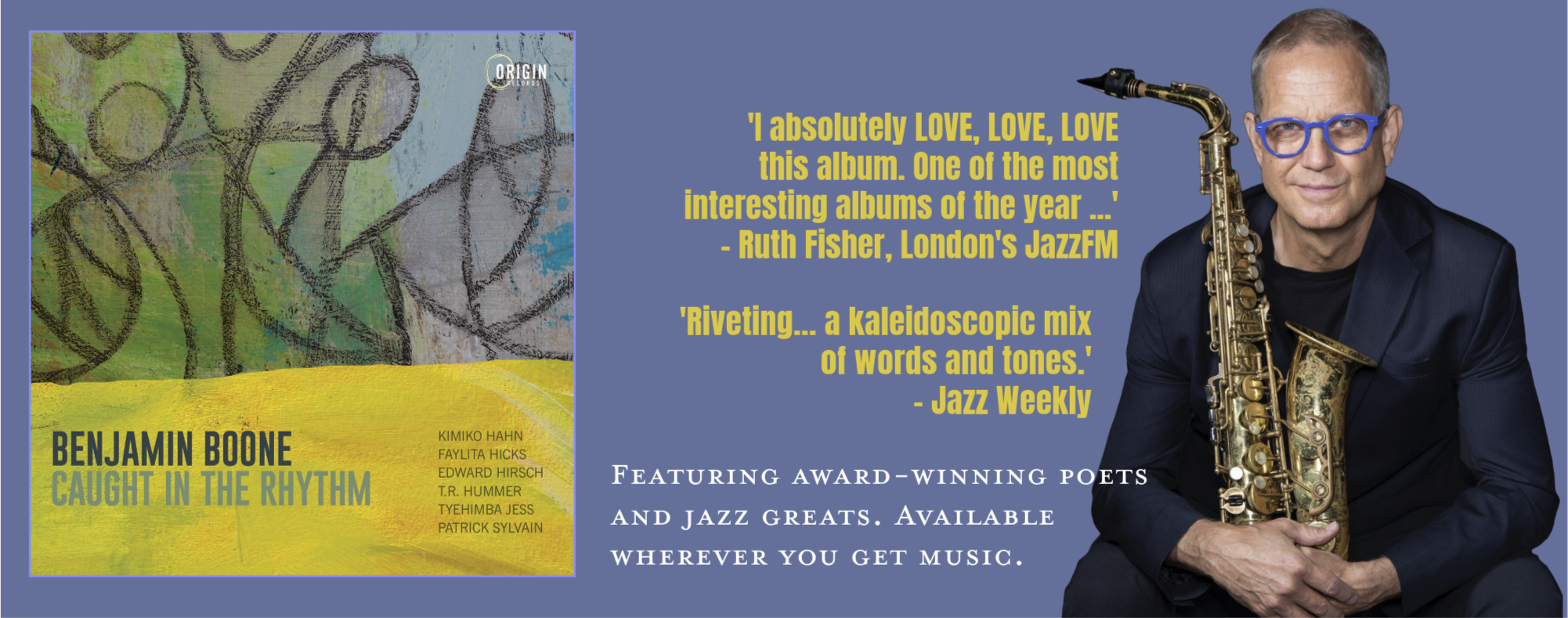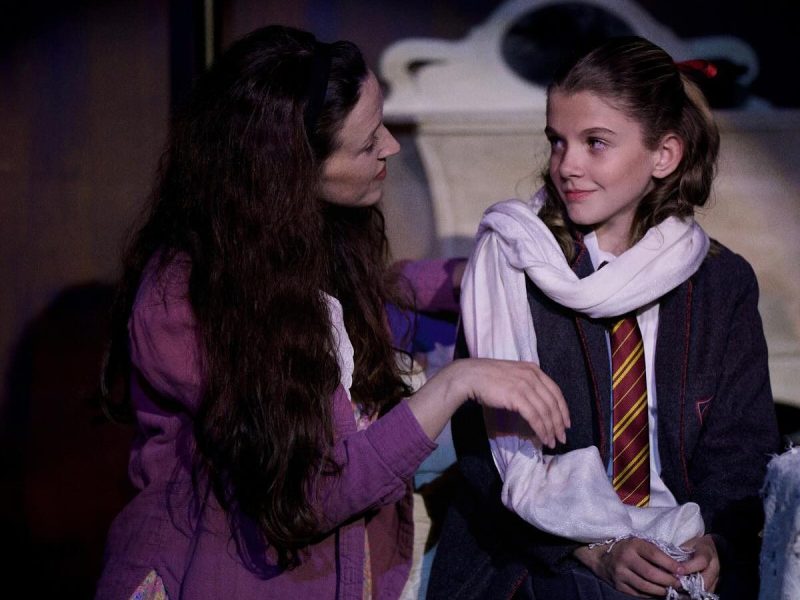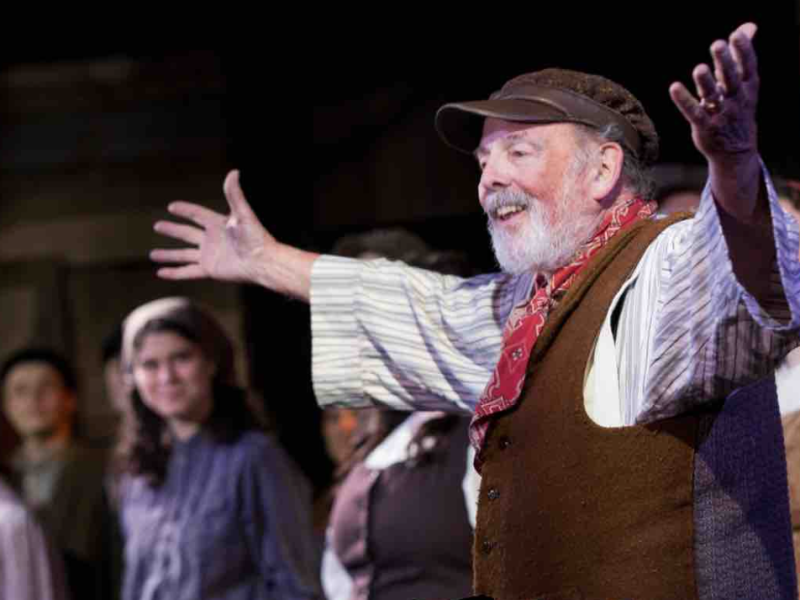Review: For Fresno City College, a moving ‘Plague Diaries’ offers a sense of the isolation we’re all experiencing
In “Plague Diaries,” the first glimpse of Fresno is an aerial shot of an empty road slicing through a bare field. There is no city here: no buildings or greenery, no gas stations or dollar stores. No people. Just an overhead view of an undeveloped swath of land baked a crunchy, golden brown.
Pictured above: Briana Villanueva offers a potent performance in ‘Party at Miranda’s.’ Photo: Fresno City College
Then the camera shifts perspective, tilting upward to provide a view of the horizon. The edge of a housing development — the furthermost edge of the city — comes into the frame. Go past that edge and you are awash in metropolitan life: houses, streets, trees, lawn chairs, kids riding bikes on hot summer days. On one side of the line, no people. On the other, lots of people crowded together. That’s what people do in cities. They share things: infrastructure, identity, resources, a sense of place and belonging.
They also share viruses.
 I love this opening credit sequence because of the mood it imparts to the rest of “Plague Diaries,” an ambitious and moving anthology of short films from Fresno City College. Current and former students in Charles Erven’s playwriting and screenwriting courses were teamed with student filmmakers and student composers. Conceived by Erven, who also produced with Steven Chin, a film professor, the 51-minute pandemic project is standing in for one of the college’s regular theater productions. Each of the six vignettes offers a pandemic-related thread, some delicate, others sturdy and ropelike. Fear, frustration, loneliness, love and camaraderie are in abundance.
I love this opening credit sequence because of the mood it imparts to the rest of “Plague Diaries,” an ambitious and moving anthology of short films from Fresno City College. Current and former students in Charles Erven’s playwriting and screenwriting courses were teamed with student filmmakers and student composers. Conceived by Erven, who also produced with Steven Chin, a film professor, the 51-minute pandemic project is standing in for one of the college’s regular theater productions. Each of the six vignettes offers a pandemic-related thread, some delicate, others sturdy and ropelike. Fear, frustration, loneliness, love and camaraderie are in abundance.
Erven was inspired by Daniel Defoe’s “A Journal of the Plague Year,” a fictional recounting of the Great Plague of London, which swept the city in 1665. Told with a narrative intensity that captures a city racked by bubonic plague, the book focuses on individual tales of despair and resilience.
Thanks to Austin Dozier’s excellent title design, which first trails along through a 17th century map of London before segueing into the Fresno outskirts shot, the Defoe connection is deftly communicated to the viewer. The six vignettes are labeled “chapters” and include relevant quotes from Defoe over more drone footage of Fresno’s mostly empty streets. The footage, shot by photography professors John Burroughs and John Huewe, is a key addition to the film’s creative impact, as is the opening original musical score by Christopher Brady, a music professor, and Orion Luminiferous, a student.
In the opening sequence, “Party at Miranda’s” (screenplay by Paola Rivera; directed and edited by Alejandro Iglesias), a young woman wallows alone in depression, ignoring her determinedly ringing iPhone. (As you’d imagine, phones play key roles in several of the vignettes.) Three friends get philosophical in “This is a Lot, Man” (screenplay by Paola Rivera; directed and edited by Tristan Ibarra Martin). “The Other Side” (screenplay by Chong Thao; directed and edited by Dylan Hardcastle) features a young man acting out an existential crisis on the streets of Fresno. “Love in the Time of Covid” (screenplay by Joseph Rivera; directed and edited by Chong Thao) explores the bitterness of separated romantic partners. The closing vignette, “Reclamation” (screenplay by Matthew Robinson; directed and edited by Enrique Martin-Valdepeña), highlights the healing role of art in crisis.
Show info
‘Plague Diaries,’ a Fresno City College production. Premieres online 7 p.m. Friday, Jan. 15 (there will be a live-chat feature opening night with cast and crew). The film will stream for three additional performances (7 p.m. Saturday, Jan. 16; 2 p.m. Sunday, Jan. 17; and 7 p.m. Monday, Jan. 18), followed by a release on Tuesday, Jan. 19, on YouTube. For free tickets to the Jan. 15-18 streaming performances, go to Eventbrite.
A common theme is isolation. It makes me sad to think of college students today who are stuck apart from each other. Think of the friendships that aren’t being made, the love affairs that aren’t happening, the school activities and bonding moments that are being lost. When you’re older, you can chill at home for a year and not be noticeably worse for the wear. When you’re young, I’m not so sure. That sense of loss translates into the material of the film.
Some of the acting is wonderful; some is OK. The same goes for the writing, cinematography, sound and direction. That’s to be expected, and even celebrated, in a project such as this. Several of the vignettes (“Love in the Time of Covid,” “The Other Side”) feel plodding in the pacing of the dialogue; some of the natural interior lighting in “Love” and “Reclamation” comes across as murky, not artsy. In terms of storylines, a couple of them have nuanced revelations/plot twists that I’m suspecting would be hard for some viewers to pick up on just one viewing.
Related story: THEATER GOES ON THIS SEASON AT FRESNO STATE, FRESNO CITY AND COS
Still, much of “Plague Diaries” looks and sounds quite well. It is a collaborative work in the truest sense of the word, incorporating professionals and students, and its greatest strength is the diversity of talents, viewpoints and life experiences. This film bristles with a sense of people coming together creatively and in synergy. That very energy gives it impact.
Two of the vignettes stand out most to me. Iglesias’ direction and editing in “Party at Miranda’s” is powerful. (Two of my favorite shots: an opaque car window rises in a parking lot; a fleeting glimpse of a nighttime bike ride.) In a significant performance that is almost wordless, Briana Vilanueva plays the title character with a startling, potent presence.
And “Six Feet” (screenplay by Michael Christopher Flores; directed by Flores and Dylan Hardcastle) brings a bit of whimsy to the proceedings. Two young men (Flores and Anthony Folmer) are forced apart because of the virus, but they’re able to come together in dance. The vignette is a bit rough technically — shooting the choreography at night was a very difficult order to pull off — but I love the sense of fantasy, the idea that film can overcome the limitations of the physical world and bring people together.
Perhaps my favorite touch in the whole film: In the opening-credit sequence, Dozier (the titles designer) highlights a line from Defoe:
A dreadful plague in London was
In the year sixy-five
Which swept a hundred thousand souls
Away; yet I alive
As the screen fades to black, all the words except the final three vanish. “yet I alive” remains for a moment, then the first two words fade, too, leaving just the final one.
For those of us who have thus far survived the plague, that’s something to be thankful for.










